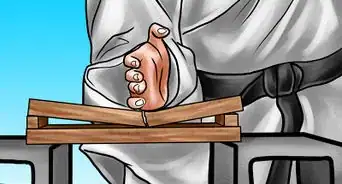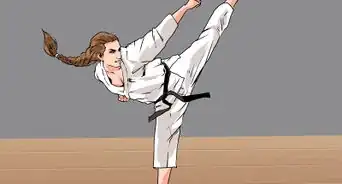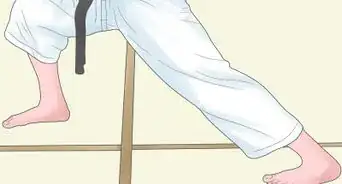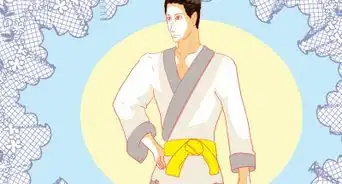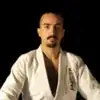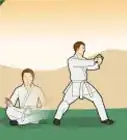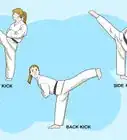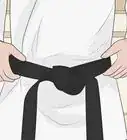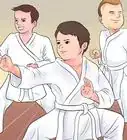This article was co-authored by George Rego. George Rego is a lifelong Martial Arts Expert, Self-Defense expert, and Author of the book, The Founding of Jujutsu & Judo In America. With over 30 years of experience, he specializes in the self-defense arts of Jukido Jujitsu and Kokondo Karate. He is currently a 5th-degree black belt in jujitsu (jiu-jitsu) and a 3rd-degree black belt in karate. While he has been a successful competitor, including being the 2015 National Freestyle Judo Lightweight Champion, his focus remains on learning and teaching martial arts for real-world self-defense. He is the National Jujitsu Director for the IKA and the Chief Instructor of the most well-attended Jukido Jujitsu school in the world, the Jukido Academy in Palm Coast, Florida, where he teaches people from all walks of life - from those with special needs to those who serve in the military special forces.
This article has been viewed 53,156 times.
Karate is a very complex and unique art that requires lots of practice and passion. But where there's a will there's a way: with some knowledge of the basics, you can create your own training regimen and practice at home. And with a few universal tips and knowledge, your progression through the process will be as smooth and enjoyable as possible.
Steps
Practicing Karate at Home
-
1Try to set aside time every day to practice. Karate is all about structure and discipline. With these principles in mind, it only makes sense to structure your practice. Even when practicing at home, it's important to stick to the same practice time each day as much as possible. By sticking to a schedule, progress is guaranteed and your work goes much further!
- Select a time that doesn't interfere with dinner plans or schoolwork.
- Find a friend that's willing to stick it out and practice the same days with you!
-
2Wear comfortable clothes like baggy shorts or sweatpants with a T-shirt. Most karate classes will recommend that you wear something comfortable and loose. You can also purchase a traditional karate uniform from an online supplier if you want to really get in the zone.Advertisement
-
3Purchase a body opponent bag so it's easier to practice on your own. If you're willing to make the investment, you can get a body opponent bag from an online supplier or local martial arts shop. This will make it much easier to warm up and practice without a friend.
- If you have friends that want to learn karate, have them practice with you!
-
4Stretch and workout before your training starts to prepare your body. Always get a good 15-minute stretch in and make sure it covers all aspects of the body: arms, quads, calves, groin muscles, back, neck, ankles, and wrists. For workouts, try regular crunches, full-body crunches, regular pushups, triangle pushups, fingertip pushups, squats, and lunges.[1]
- To stretch your thighs, stand on one foot, bend one leg back into your corresponding hand, and apply pressure toward your body.
- Try Chinese splits, which involves standing upright, placing your hands on the floor, and then extending one leg back and one forward.
- Face a wall and spread your legs as far out as you can. Each time you spread wider, slide yourself closer to the wall. Gauge your improvement by how close your chest is to the wall each time.
-
5Warm up with your stance before you begin practicing specific technique. Stances are the very basis of your basics—no matter what stance you're in, your knees should always be bent! Without a good stance, you can't do anything else! You should be able to perform a stance anywhere, whether you're on a sandy beach, rocky mountain, or urban terrain.
- Warm up with your stance before jumping into defensive and offensive techniques.
Practicing Defensive Techniques
-
1Practice lowering your center of gravity. Each style you train in will have its own set of blocks. But no matter what style you train in, all of your blocks should pass through the center of the body. Typically, this is accomplished by bending your knees to lower your center of gravity and keeping your feet wide outside of your shoulder width.
- Every time you block an attack, be sure that you are not falling off balance. If you are, this is a sign that you are not lowering your center of gravity effectively.
- If you have a body opponent bag, push it away from you while maintaining your center of gravity. As it moves back toward you, practice blocking it while keeping your center of gravity.
-
2High block by bringing either arm across your body to your forehead. Visualize your opponent trying to punch you on top of your head. Always make sure your arm is right in front of your forehead as you block. Keep your palm facing towards your opponent and your arm tilted up at a 45-degree angle. Make sure your arm is covering your whole head.
- Use this block if someone is trying to strike you on top of your head with their bare hand.
- Imagine you are blocking a punch from both a left and right arm to get comfortable with this motion.
-
3Forward block by rotating a bit past your centerline. Use the arm on whichever side your opponent is striking (or whichever side you visualize them striking) and move it across your body so that it touches your opposite shoulder. From here, bring it back to its proper side while ensuring that your hips return to your base stance with it. Make sure your arm does not go past your shoulder and keep your palm facing towards your opponent.
- Make sure your hand reaches as high as your head.
- Use this block to defend a round punch coming to the side of the head.
- Whether you practice with a friend or alone, always consider punches coming from both the left and right side.
-
4Cross block by moving either arm to your ear and across your face. Your hand should move as high as your head. Keep your arm tilted out at a 45-degree angle and your palm facing towards you. Make sure that your arm goes fully across your face.
- Turn your hips in the direction of your hand movement to increase the block's power.
- Use this block to defend a strike coming straight into your face.
-
5Downward circle block by bringing the opponent's arm down past you. Practice this block with a friend—doing so alone is difficult. Keep your defensive palm facing outward and your offensive arm titled at a 45-degree angle. Block the punch with your offensive forearm and step outside of your opponent's punch. Place your defensive palm on the opponent's offensive shoulder and your offensive palm on their forearm and guide them downward past you.[2]
- Guide the opponent's punch by using their force against them.
- Use this block to defend a punch coming into the stomach.
Learning Offensive Technique
-
1Learn how to throw basic Karate punches. Stand with your feet shoulder width apart and hold one fist straight out in front of you. Keep your other arm bent in an L-shape with your fist facing upward. When you punch, bring your bent arm forward and turn your fist downward. Always use your hips—70% of the power from your punch comes from here. Tilt your fist at a 45-degree angle downward to keep the wrist stable— those are the only knuckles that have bones connecting to the arm bone![3]
- Always tilt your wrist downward so you are hitting with your first 2 knuckles, also known as the unit knuckles. This also prevents you from hyperextending your elbow.
- Twist your wrist back to facing upward as you draw the punch back to release your locked elbow.
-
2Practice snap kicking motions and progress your speed. Stand with your feet shoulder-width apart. Raise your knee a bit past your waist if you're kicking to the waist or almost all the way to the chest or higher to kick to the face. Keep your toes pointed down as your knee is raised. Now, extend your leg straight while keeping your foot straight and pointing toward your opponent. Continue practicing this motion and increase the speed as you get more comfortable with it.[4]
- Start by practicing waist-level snap kicks before progressing higher.
- Be sure to strike blade of your foot with heaviest impact at the heeled of the bladed foot.
- Use these kicks to lighten up your opponent and throw them off balance.
-
3Practice thrust kicks to push your opponent back. Lift your knee toward your chest and turn your shoulders as you raise it. Flex your ankle upward toward the shin. Thrust the bottom of your foot toward the target and strike it (or them) with your heel or the bottom of your foot.[5]
- Practice thrust kicks on a punching bag and increase their force as you get more comfortable.
- Once you're comfortable with your kicks, practice on a friend that knows Karate and is comfortable blocking.
Expert Q&A
-
QuestionHow do you go up in belts in karate?
 George RegoGeorge Rego is a lifelong Martial Arts Expert, Self-Defense expert, and Author of the book, The Founding of Jujutsu & Judo In America. With over 30 years of experience, he specializes in the self-defense arts of Jukido Jujitsu and Kokondo Karate. He is currently a 5th-degree black belt in jujitsu (jiu-jitsu) and a 3rd-degree black belt in karate. While he has been a successful competitor, including being the 2015 National Freestyle Judo Lightweight Champion, his focus remains on learning and teaching martial arts for real-world self-defense. He is the National Jujitsu Director for the IKA and the Chief Instructor of the most well-attended Jukido Jujitsu school in the world, the Jukido Academy in Palm Coast, Florida, where he teaches people from all walks of life - from those with special needs to those who serve in the military special forces.
George RegoGeorge Rego is a lifelong Martial Arts Expert, Self-Defense expert, and Author of the book, The Founding of Jujutsu & Judo In America. With over 30 years of experience, he specializes in the self-defense arts of Jukido Jujitsu and Kokondo Karate. He is currently a 5th-degree black belt in jujitsu (jiu-jitsu) and a 3rd-degree black belt in karate. While he has been a successful competitor, including being the 2015 National Freestyle Judo Lightweight Champion, his focus remains on learning and teaching martial arts for real-world self-defense. He is the National Jujitsu Director for the IKA and the Chief Instructor of the most well-attended Jukido Jujitsu school in the world, the Jukido Academy in Palm Coast, Florida, where he teaches people from all walks of life - from those with special needs to those who serve in the military special forces.
Martial Arts Expert In legitimate styles of karate, the advancement from belt rank to belt rank is a process or continuous cycle which very broadly goes as follows: 1) Learn techniques, kata, and other elements of curriculum appropriate for one's current rank. 2) Once learned, practice and develop these elements until they become muscle memory. 3) Pressure-test these refined techniques with training partners and drills. 4) Take feedback from pressure tests and use it for further training. 5) The student undergoes a formal rank evaluation. 6) If successful, the student is awarded a new belt rank and begins again at step 1.
In legitimate styles of karate, the advancement from belt rank to belt rank is a process or continuous cycle which very broadly goes as follows: 1) Learn techniques, kata, and other elements of curriculum appropriate for one's current rank. 2) Once learned, practice and develop these elements until they become muscle memory. 3) Pressure-test these refined techniques with training partners and drills. 4) Take feedback from pressure tests and use it for further training. 5) The student undergoes a formal rank evaluation. 6) If successful, the student is awarded a new belt rank and begins again at step 1. -
QuestionWhat are good kata to practice for beginners?
 George RegoGeorge Rego is a lifelong Martial Arts Expert, Self-Defense expert, and Author of the book, The Founding of Jujutsu & Judo In America. With over 30 years of experience, he specializes in the self-defense arts of Jukido Jujitsu and Kokondo Karate. He is currently a 5th-degree black belt in jujitsu (jiu-jitsu) and a 3rd-degree black belt in karate. While he has been a successful competitor, including being the 2015 National Freestyle Judo Lightweight Champion, his focus remains on learning and teaching martial arts for real-world self-defense. He is the National Jujitsu Director for the IKA and the Chief Instructor of the most well-attended Jukido Jujitsu school in the world, the Jukido Academy in Palm Coast, Florida, where he teaches people from all walks of life - from those with special needs to those who serve in the military special forces.
George RegoGeorge Rego is a lifelong Martial Arts Expert, Self-Defense expert, and Author of the book, The Founding of Jujutsu & Judo In America. With over 30 years of experience, he specializes in the self-defense arts of Jukido Jujitsu and Kokondo Karate. He is currently a 5th-degree black belt in jujitsu (jiu-jitsu) and a 3rd-degree black belt in karate. While he has been a successful competitor, including being the 2015 National Freestyle Judo Lightweight Champion, his focus remains on learning and teaching martial arts for real-world self-defense. He is the National Jujitsu Director for the IKA and the Chief Instructor of the most well-attended Jukido Jujitsu school in the world, the Jukido Academy in Palm Coast, Florida, where he teaches people from all walks of life - from those with special needs to those who serve in the military special forces.
Martial Arts Expert Kata curricula vary widely from style to style in karate. As such, good kata for a beginner to practice are best decided by one's direct teacher or sensei. With that being said, there are some kata that are widely practiced in many or most styles of karate. These kata tend to be either designed to introduce beginners to the practice of kata itself and/or to begin developing the core of one's karate foundation. Kata typically found in this category are: Taikyoku Shodan, Taikyoku Nidan, Taikyoku Sandan, Pinan Shodan (aka Heian Shodan), and Pinan Nidan (Heian Nidan).
Kata curricula vary widely from style to style in karate. As such, good kata for a beginner to practice are best decided by one's direct teacher or sensei. With that being said, there are some kata that are widely practiced in many or most styles of karate. These kata tend to be either designed to introduce beginners to the practice of kata itself and/or to begin developing the core of one's karate foundation. Kata typically found in this category are: Taikyoku Shodan, Taikyoku Nidan, Taikyoku Sandan, Pinan Shodan (aka Heian Shodan), and Pinan Nidan (Heian Nidan). -
QuestionHow can I improve my karate at home?
 George RegoGeorge Rego is a lifelong Martial Arts Expert, Self-Defense expert, and Author of the book, The Founding of Jujutsu & Judo In America. With over 30 years of experience, he specializes in the self-defense arts of Jukido Jujitsu and Kokondo Karate. He is currently a 5th-degree black belt in jujitsu (jiu-jitsu) and a 3rd-degree black belt in karate. While he has been a successful competitor, including being the 2015 National Freestyle Judo Lightweight Champion, his focus remains on learning and teaching martial arts for real-world self-defense. He is the National Jujitsu Director for the IKA and the Chief Instructor of the most well-attended Jukido Jujitsu school in the world, the Jukido Academy in Palm Coast, Florida, where he teaches people from all walks of life - from those with special needs to those who serve in the military special forces.
George RegoGeorge Rego is a lifelong Martial Arts Expert, Self-Defense expert, and Author of the book, The Founding of Jujutsu & Judo In America. With over 30 years of experience, he specializes in the self-defense arts of Jukido Jujitsu and Kokondo Karate. He is currently a 5th-degree black belt in jujitsu (jiu-jitsu) and a 3rd-degree black belt in karate. While he has been a successful competitor, including being the 2015 National Freestyle Judo Lightweight Champion, his focus remains on learning and teaching martial arts for real-world self-defense. He is the National Jujitsu Director for the IKA and the Chief Instructor of the most well-attended Jukido Jujitsu school in the world, the Jukido Academy in Palm Coast, Florida, where he teaches people from all walks of life - from those with special needs to those who serve in the military special forces.
Martial Arts Expert Always consult with your karate sensei on this question—one's karate teacher will have the most specific advice to give on home training given the strengths, weaknesses, rank, and ability of the student in question. Generally speaking, one can improve their karate at home by refining and fine-tuning elements of basic techniques. In karate, these fundamental techniques are called kihon-waza. Slowly practicing the kihon-waza in front of a mirror can be helpful for a beginner in catching mistakes and correcting their form in real time.
Always consult with your karate sensei on this question—one's karate teacher will have the most specific advice to give on home training given the strengths, weaknesses, rank, and ability of the student in question. Generally speaking, one can improve their karate at home by refining and fine-tuning elements of basic techniques. In karate, these fundamental techniques are called kihon-waza. Slowly practicing the kihon-waza in front of a mirror can be helpful for a beginner in catching mistakes and correcting their form in real time.
Expert Interview

Thanks for reading our article! If you'd like to learn more about karate basics, check out our in-depth interview with George Rego.
References
About This Article
To learn the basics of karate, familiarize yourself with the specific stances associated with your chosen martial arts style and warm up before each training session with these stances. Next, work on defensive techniques like high blocks, forward blocks, and cross blocks so you can protect yourself against your opponent. Then, work on basic offensive moves like punches, snap kicks, and thrust kicks. If you need more guidance, try practicing along with online video tutorials! To learn more about how to perform specific moves, read on!

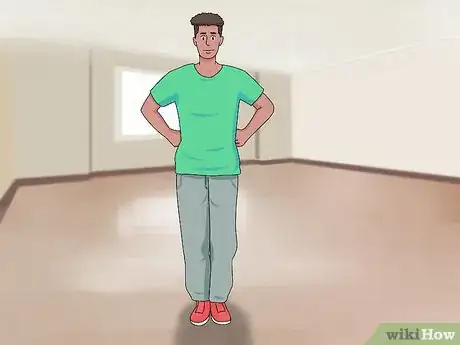
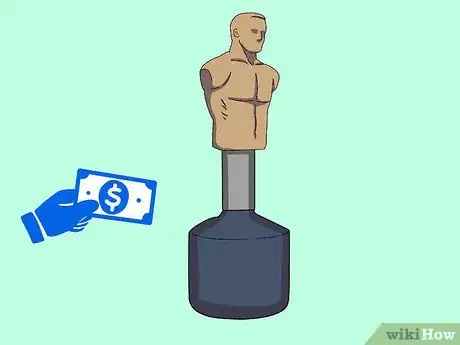
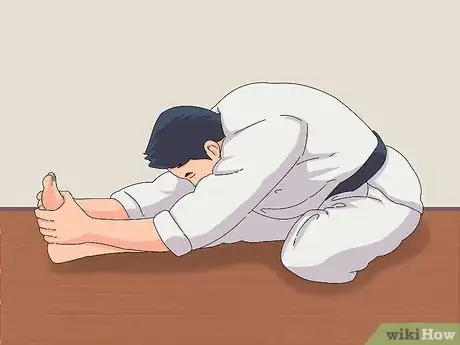
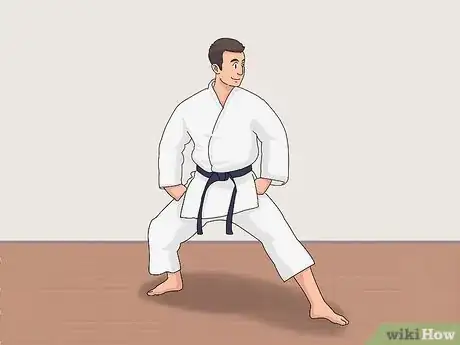
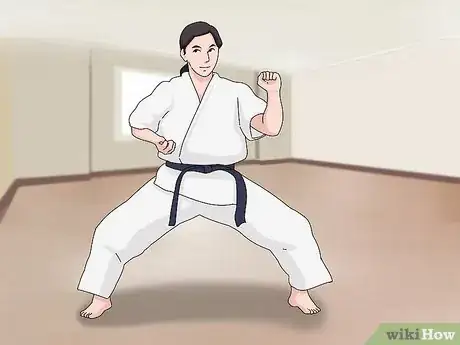
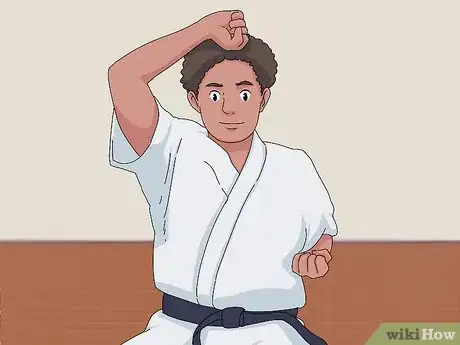

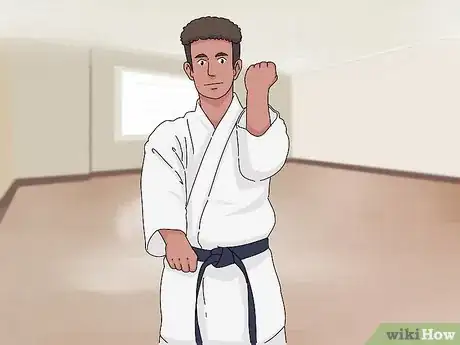
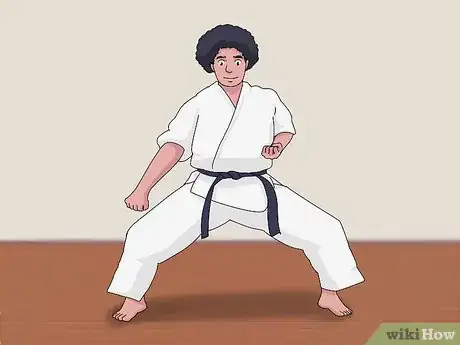
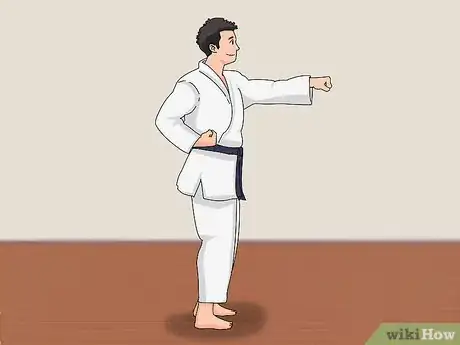


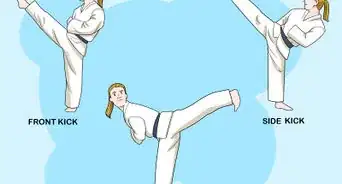
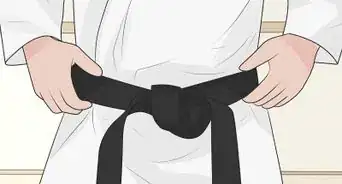

-Step-7-Version-2.webp)
